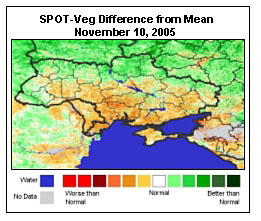Ukraine: Slight Improvement in Winter Grain Conditions
Sown winter-grain area for 2006/07 dropped by nearly 20 percent from last year in Ukraine. The reduction in area is attributed chiefly to persistent fall dryness that also hampered winter-crop emergence and establishment. According to preliminary data from the State Statistical Committee, winter grains were planted on 6.06 million hectares (against 7.46 million last year), including 5.14 (6.32) million wheat, 0.54 (0.48) million barley, and 0.38 (0.66) million rye. Winter wheat typically comprises about 95 percent of total wheat area in Ukraine, and all of the rye in Ukraine is winter rye. Winter barley accounts for only about 10 percent of total barley area and is grown only in southern Ukraine. (Spring barley is one of Ukraine's chief grain crops, and is typically planted in March.)
 The drought in Ukraine's key winter wheat region began in late August and intensified through early October. Beneficial rainfall during October and November reversed the dryness and helped replenish depleted soil moisture reserves. Crop conditions reportedly improved during December. UkrAgroConsult, a leading commodity-analysis group in Kiev, estimated on December 20 that 70 percent of the country's winter wheat area was in good or satisfactory condition -- an improvement over the 62 percent reported on December 1 but down considerably from the 90 percent rated in good or fair by the Ministry of Agriculture at roughly the same date last year. Other local reports indicate that the effect of the drought was most severe in eastern and southern Ukraine, while conditions were more favorable farther north. This is consistent with SPOT-Veg satellite imagery indicating that crop conditions were generally worse than normal on November 10, as the crop was preparing to enter dormancy in many parts of the country. The drought in Ukraine's key winter wheat region began in late August and intensified through early October. Beneficial rainfall during October and November reversed the dryness and helped replenish depleted soil moisture reserves. Crop conditions reportedly improved during December. UkrAgroConsult, a leading commodity-analysis group in Kiev, estimated on December 20 that 70 percent of the country's winter wheat area was in good or satisfactory condition -- an improvement over the 62 percent reported on December 1 but down considerably from the 90 percent rated in good or fair by the Ministry of Agriculture at roughly the same date last year. Other local reports indicate that the effect of the drought was most severe in eastern and southern Ukraine, while conditions were more favorable farther north. This is consistent with SPOT-Veg satellite imagery indicating that crop conditions were generally worse than normal on November 10, as the crop was preparing to enter dormancy in many parts of the country.
Although excessive fall dryness was the main reason for the 20-percent drop in sown winter grain area (area typically drops in years marked by unusually dry planting conditions), a significant shift in wheat and barley prices likely played a role as well. In early September 2004, which was the beginning of the planting season for 2004/05 winter grains, feed wheat prices were 15 to 20 percent higher than feed barley prices. In September 2005, the situation was reversed: feed barley prices were over 50 percent higher than feed wheat prices, and 20 percent higher than prices for 4th class (milling) wheat. The low prices for wheat relative to barley (a spring-planted crop), combined with a higher cost of production, likely influenced farmers' fall planting decisions and contributed in part to the drop in 2006/07 winter wheat area.
Official USDA area and production estimates for grains and other agricultural commodities are available at PSD Online. Initial estimates for 2006/07 will be released on May 12, 2006.
|

